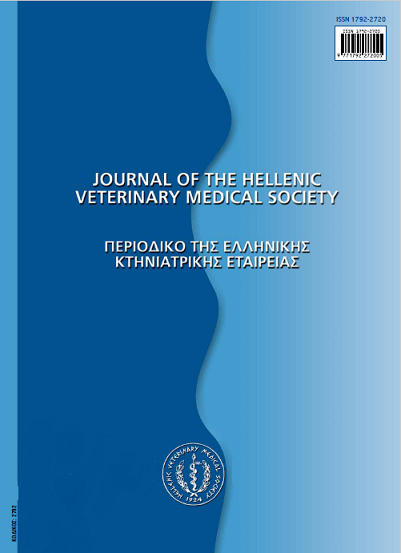Τρόφιμα ως πιθανή πηγή μόλυνσης των θηλαστικών με τoν ιό γρίπης Η5Ν1

Περίληψη
Τα πρόσφατα κρούσματα γρίπης ανθρώπων και άλλων θηλαστικών από τον υψηλής λοιμογόνου ικανότητας ιό της γρίπης των πτηνών Η5Ν1 έχουν προκαλέσει ερωτήματα σχετικάμε την ασφάλεια της κατανάλωσης των πτηνοτροφικών προϊόντων.Ο σκοπός αυτής της ανασκόπησης είναι η συλλογή και παρουσίαση πληροφοριών αναφορικά με τον κίνδυνο της προσβολής των ανθρώπων από τον ιό Η5Ν1 μέσω της στοματικής οδού. Η παρουσίατου ίου στα εδώδιμα πτηνοτροφικά προϊόντα και οι αλλαγές εισόδου του ίου μέσω του γαστροεντερικου σωλήνα (Gl), καθώς και οι πιθανότητες της εισαγωγής του μέσω του γαστροεντερικου σωλήνα (Gl), από απόψεως λοιμογόνου ικανότητας, είναι τα κυρία σημεία εστίασης. Η μετάδοση του Η5Ν1 από τα πτηνά στον άνθρωπο είναι σπάνια και έχει συνδυαστεί με την πολύ στενή επαφή του ανθρώπου με τα ασθενή ζώα. Είναι γενικά αποδεκτό ότι οι πλέον πιθανοί οδοί εισόδου του ίου είναι η στοματοφαρυγγική και/ή οι ιστοί του αναπνευστικού σωλήνα όπου μπορεί να συμβεί η αντιτυπωση του ίου και να οδηγήσει σε κλινικά συμπτώματα. Όμως, ο μικρός αριθμός περιστατικών σε ανθρώπους σε σύγκριση με το μεγάλο αριθμό των ανθρώπων που έχουν έρθει σε επαφή με ασθενή από τον ιό Η5Ν1 ζώα, αποδεικνύει καθαρά ότι δεν υφίσταται εύκολα αποδεκτή θύρα εισόδου. Η πιθανότητα εισόδου του ίου μέσω του Gl σωλήνα έχει προταθεί, αλλά μέχρι τώρα δεν έχει αποδειχθεί ότι ο ιός μπορεί να αντιτυπωθεί στο έντερο του ανθρώπου.Η ύπαρξη διάρροιας σε μερικούς ασθενείς και η εύρεση του ίίκου RNA σε ληφθέν υλικό (swabs) από το έντερο και το ορθό τριών ασθενών δεν επιτρέπει να εξαχθεί, με ασφάλεια, συμπέρασμα ότι ο Gl σωλήνας μπορεί χρησιμεύει ως θύρα εισόδου ή όργανο στόχου. Περαιτέρω, τα περιστατικά της νόσου σε ανθρώπους δεν έχουν καθαρά ή οριστικά συνδεθεί με την κατανάλωση κρέατος πτηνών. Είδη αιλουροειδών, αφετέρου, έχουν φυσικά και πειραματικά μολυνθεί μετά την κατανάλωση προσβεβλημένων πτηνών. Όμως, επίσης και σε αυτά τα θηλαστικά, δεν επιβεβαιώθηκε ότι το έντερο ήταν η αρχική θύρα εισόδου χου ίου. Συμπερασματικά, η πιθανότητα ο εντερικός σωλήνας να χρησιμεύει στα θηλαστικά ως θύρα εισόδου παραμένει απίθανο, μιας και δεν υπάρχει καμία πειστική απόδειξη όχι οι ιστοί του GI σωλήνα μπορεί να υποστηρίζουν την αντιτύπωση του ίου. Όμως, δεν μπορεί να αποκλειστεί ότι τρόφιμα τα οποία περιέχουν τον ιό μπορεί να αποτελέσουν πηγή μόλυνσης όταν περνούν τους στοματο-φαρυγγικούς ιστούς, οι οποίοι έχουν ταυτοποιηθεί ως σημεία-σχόχοι για την αντιτύπωση του ιού.
Λεπτομέρειες άρθρου
- Πώς να δημιουργήσετε Αναφορές
-
PENSAERT, M., KYRIAKIS, C. S., & van REETH, K. (2017). Τρόφιμα ως πιθανή πηγή μόλυνσης των θηλαστικών με τoν ιό γρίπης Η5Ν1. Περιοδικό της Ελληνικής Κτηνιατρικής Εταιρείας, 58(3), 220–231. https://doi.org/10.12681/jhvms.14987
- Τεύχος
- Τόμ. 58 Αρ. 3 (2007)
- Ενότητα
- Short Communication
Οι συγγραφείς των άρθρων που δημοσιεύονται στο περιοδικό διατηρούν τα δικαιώματα πνευματικής ιδιοκτησίας επί των άρθρων τους, δίνοντας στο περιοδικό το δικαίωμα της πρώτης δημοσίευσης.
Άρθρα που δημοσιεύονται στο περιοδικό διατίθενται με άδεια Creative Commons 4.0 Non Commercial και σύμφωνα με την άδεια μπορούν να χρησιμοποιούνται ελεύθερα, με αναφορά στο/στη συγγραφέα και στην πρώτη δημοσίευση για μη κερδοσκοπικούς σκοπούς.
Οι συγγραφείς μπορούν να καταθέσουν το άρθρο σε ιδρυματικό ή άλλο αποθετήριο ή/και να το δημοσιεύσουν σε άλλη έκδοση, με υποχρεωτική την αναφορά πρώτης δημοσίευσης στο J Hellenic Vet Med Soc
Οι συγγραφείς ενθαρρύνονται να καταθέσουν σε αποθετήριο ή να δημοσιεύσουν την εργασία τους στο διαδίκτυο πριν ή κατά τη διαδικασία υποβολής και αξιολόγησής της.



